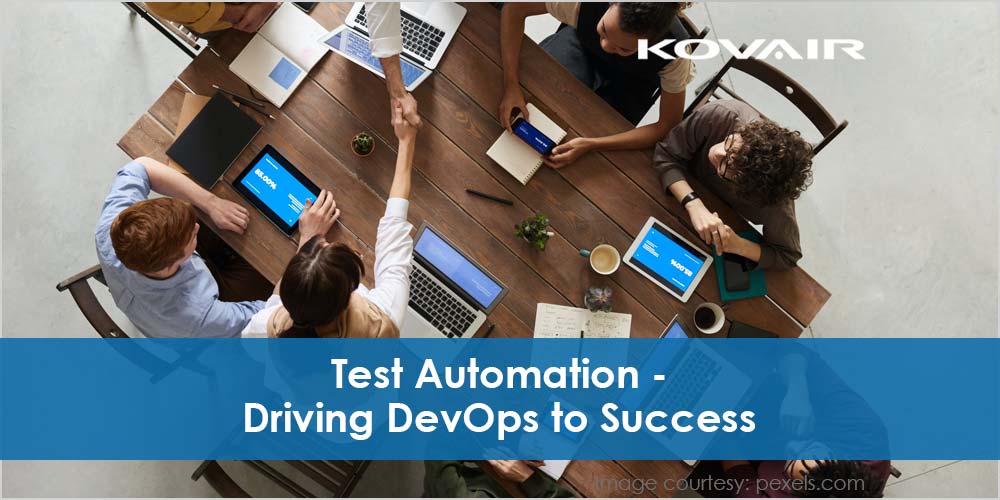
In earlier days, development(Dev) and operations(Ops) activities used to function in silos. But in the case of DevOps, it is not so. They work together, always. Continuous integration and continuous delivery (CI/CD) are considered as pillars of successful DevOps.
And, as they say, “Continuous integration and continuous delivery isn’t continuous without test automation.” Hence, in the real DevOps world, the development engineers and the QA engineers who build automated tests also need to work together as closely as possible.
DevOps is a set of practices and cultural philosophies that amalgamates the activities concerning software development and the activities of the IT operations. Hence, it binds people, process, and automation close together.
The goal of using DevOps is to shorten the systems development life cycle and provide continuous delivery (CD). Eventually, the team can build, test, and release software faster and more reliably.
Impact of Automated Tests in the DevOps World
Testing is a part of the release pipeline. And, test automation is missed out in several projects, and the result is not the intended CI/CD goals of the DevOps. If we performed the tests manually, many steps in the release pipeline would slow down. Not only that, errors are more likely to occur. Test automation introduces speed and accuracy, making a higher-quality delivery at a faster rate possible, compared to manual tests.
We also know that if we used powerful test automation tools like TestProject, Parasoft, etc., we could attain several advantages. Benefits of using these new-age, smart AI-enabled tools include quicker test results, faster error identification, faster debugging and fixes, and ease of maintenance of tests thanks to self-healing AI features, and much more!
Successful DevOps – Choosing the right tool for Automating Tests
Several test automation tools are contributing to, as well as becoming an essential part of DevOps continuous automation success. Several New Age automation tools allow easy integration to CI/CD tools. Hence, you have to choose the right tool for test automation that will allow this integration. The tool should be easy to integrate, as well.
[the_ad id=”2867″]
For example, in the case of TestProject, the automated tests can be easily integrated with tools like Jenkins, etc. within a few minutes. Once that is done, you can quickly go ahead and incorporate your automated tests in the CI process.
The learning curve of enabling the integration should be this simple while using the tool. Also, once a job is run from the CI/CD tools, the results should be easily viewed in both the CI/CD tool and the test automation tool. Reports supporting Test Analytics should be available to help the developer analyze and debug the results.
For an end-to-end automation enablement feeling, if the tool has self-healing AI technology, maintenance of the test automation is managed to be kept to the bare minimum. For example, let us assume the non-AI enabled test automation recorded a set of user actions, as per the steps of a test case. Next, if a developer made a change into the text box widget’s UI ID property, and the automation code was not updated as per this change, then the automation would have failed.
But this is not the case if an AI-enabled test automation tool was used. In the case of AI-enabled test automation tools, the self-healing capabilities, ML, predictability features, etc., help the code fix itself without any human intervention in case it encounters such errors, and continues the test run. Zero manual intervention in maintenance results in a purely end-to-end automated setup for automation in DevOps.
Of course, no test automation framework is useful unless designed well. QA engineers need to plan the tests well with the Traceability matrix for wholesome test coverage planning. Also, before starting up, they need to decide what is ideal for automating and what is not suitable for automating. They should also identify the feedback mechanism required for quick error detection and resolving the errors.
During test automation development, the automation developers can aim for a Test data-driven approach as well to further amplify the test automation strategy. Test data planning has to be the base of any test. In the event there are many combinations involved in the test data, they can even consider Combinatorial Test Design to ensure maximum test data coverage. They also need to ensure there is reusability in the code and enhanced clarity so that maintenance is straightforward.
The Apparent Fact – DevOps cannot thrive without Test Automation
When change requests are coming from the client, thanks to DevOps, we can quickly incorporate those changes coming from the customers and then relaunch the product, if required, without any hassles. When a product needs to be tested across platforms, without test automation in hand, it would not be possible to deliver the test results swiftly. With many test automation tools providing cross-platform and even cross-device support, every real user scenario is automatable.
With DevOps, we make the product pass through the tests with powerful test automation tools, so that we are not pushing the product into a low-quality deliverable. We make the product pass through a QA pipeline as such so that they come out clean without defects – because any defect that reaches the customer becomes expensive to the client.
Hence, we have to remember that the intention of quick deliveries should not make us forget that the product needs to be thoroughly tested. Also, whenever there are defects that reach the customer, they need to be quickly fixed and tested. Manual testing doesn’t produce the best results in that case. Hence, we need to follow a robust approach and identify and resolve errors rapidly in the pipeline, which is only possible through test automation.
Wrap Up
DevOps supports continuous development as the product is built, deployed, tested, and released for use by the end-user. Building a fully automated DevOps pipeline is not a simple task. To call it as end-to-end automation is done by best combining it with automation testing rather than manual testing.
This strategy ensures high quality and faster delivery, resulting in continuous testing and continuous delivery along with ensuring a high-quality product. Make it an essential point to choose smart AI-enabled test automation tools that also enable easy integration with your DevOps toolchain. Using powerful test automation frameworks eventually speeds up your DevOps delivery.


